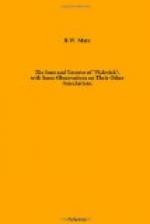In 1828, the period of The Pickwick Papers, J. Pollard painted a picture of the Cambridge coach ("The Star”) leaving the inn. A portion of this picture showing the coach and the north side of Ludgate Hill, was published as a lithograph by Thomas McLean of the Haymarket. It gives the details of the inn entrance and the coach on a large scale. The inn at the time was owned by Robert Nelson. He was a son of Mrs. Ann Nelson, the popular proprietor of the “Bull,” Whitechapel. Besides the coaches for the eastern counties, those also for other parts of the country started from its precincts, for such names as Bath, Bristol, Exeter, Plymouth, Oxford, Gloucester, Coventry, Carlisle, Manchester were announced on the signboard at the side of the archway.
In spite of the fact that Dickens only once refers to the inn, its name and fame, nevertheless, will always be associated with him and with Tony Weller, who was so familiar with it and so attached to it, as to name it as the parish he resided in.
[illustration: The Cambridge Coach leaving Belle Sauvage yard. From a lithograph]
The relating of the story of how Tony Weller was driven into his second marriage, which reveals “La Belle Sauvage” as his headquarters, also first brings into prominence the “Markis o’ Granby,” Dorking, as the residence of Mrs. Susan Clarke, and incidentally the scene of more than one amusing incident after she became Mrs. Weller, senior. “The ‘Marquis of Granby’ in Mrs. Weller’s time,” we are informed, “was quite a model of a roadside public-house of the better class—just large enough to be convenient, and small enough to be snug.”
In the chapter describing how Sam displayed his high sense of duty as a son, by paying a visit to his “mother-in-law,” as he called her, and how he discovered Mr. Stiggins indulging in “hot pine-apple rum and water,” we get a little pen-picture of the inn.
“On the opposite side of the road was a signboard on a high post representing the head and shoulders of a gentleman with an apoplectic countenance, in a red coat with deep blue facings, and a touch of the same over his three-cornered hat, for a sky . . . an undoubted likeness of the Marquis of Granby of glorious memory. The bar window displayed a choice collection of geranium plants, and a well-dusted row of spirit phials. The open shutters bore a variety of golden inscriptions, eulogistic of good beds and neat wines; and the choice group of countrymen and hostlers lounging about the stable door and horse-trough afforded presumptive proof of the excellent quality of the ale and spirits which were sold within.”
Phiz’s picture, forming the vignette on the title-page, hardly does justice to this description, although the incident of old Weller performing the “beautiful and exhilarating” act of immersing Mr. Stiggins’s head in the horse-trough full of water, is spirited enough.
The “Markis Gran by Dorken,” as the elder Weller styled it in his letter to Sam, is another of those inns, which figure prominently in the book, that have never been actually identified. Robert Allbut, in 1897, claimed to have found the original in the High Street opposite the Post Office at the side of Chequers’ Court. Only a part of it then existed, and was being used as a grocer’s shop.




